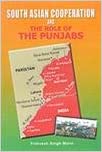South Asia Cooperation and the Role of the Punjabs

Review by Rudra Prasad Sahoo (July 10, 2007): The subject and the contents of the book titled South Asian Cooperation and the Role of the Punjabs (Tridivesh Singh Maini, Sidharth Publication, 2007) provide a new dimension to the exhaustive literature on South Asia by interpreting Punjabi culture and history and their contribution to South Asian society. By exploring the historico-cultural aspects of South Asia and providing fresh thinking on the subject, the author suggests that a cooperative framework like this might work as a vehicle of progress and peace in South Asia in general and between India and Pakistan in particular. The history of Punjabi culture, which the author has explored in his book, is based on an array of sources, primarily from poetry and religious texts, which gives some clues as to how such an alternative approach could be nurtured to improve relations between India and Pakistan.
At the outset, the author emphasizes the trajectory of cooperation in South Asia, which in turn is based more on the emotional and cultural side of the story to revive the pre-independence Punjabi bond between the two Punjabis. Later, he focuses on the more realistic component of cooperation, which includes recommendations for cooperation in the economic and political spheres.
Taking a clue from the history of cooperation in South Asia, SAARC stands as a regional cooperative framework whose main objective is to promote the welfare and development of the people of the region. SAARC has initiated some positive steps in recent times. For example, ratification of SAFTA and setting up a SAARC Development Fund and still many more new initiatives in the pipeline, which have reflected some positive trends within Search’s ambitious projects. More praiseworthy ideas have been found in the visionary leadership provided by the Prime Minister of India, Dr Man Mohan Singh, and his Pakistani counterpart Shaukat Aziz. They both have been advocating the strengthening of SAARC and improving economic ties between countries of SAARC.
But the most fascinating section of this book is the initiative taken by the two Punjabs. The memories of pre-partition united Punjab were well placed at this juncture, which was once an important trade route to central Asia. But partition signalled the separation of people having the same culture and common habits. In the last couple of years, however, great strides have been made toward improving Indo-Pakistan relations and increasing cooperation between the Punjab in particular. Some of the major initiatives in this regard are the bus services between Amritsar and Lahore, the bus service between Amritsar and Nankana Sahib, the Punjab game held in Patiala in 2004, the formation of Punjab – Punjab Consultative Committees, etc.
The chapters(third, fourth and fifth) which focus on culture, economic interest and other factors, try to justify the reason as to why and how the two Punjabs have been able to take some very important initiatives. While stressing the old Punjabi culture, the author emphasizes the reason for its bonding is mostly linked to the common saint and Sufi culture. The poetry of Sufi saints, particularly Baba Farad’s contribution to Punjabi literature, is phenomenal. Even another Punjabi poet, Shah Hussein, who is respected on both sides of Punjab, reflects a synthesis of the great culture of the greater Punjab area, which amalgamates the philosophical traditions of Islam, the Bhakti Movement and the Teaching of Guru Nanak Dev. Many more poets have also laid the groundwork for the enrichment of the Punjabi culture. They include Baba Bulle Shah and others in the medieval period, Amrita Pritam and Khuswant Singh in modern times.
To revitalize this old bonding, the post-partition phase found some new generation leadership among the people like Fakhar Zaman, who formed the World Punjabi Congress and made a serious effort for the promotion of Punjabis by pressurizing both the Governments to ease out the visa procedures for Punjabi in both sides. NGOs like Lok Sangat and many such organizations are working extensively to promote Punjabi culture in West Punjab. So the author’s argument in this regard points to the fact that culture can play a pivotal role in improving relations between the two people as well as nations.
The larger ‘culture – economy’ link seems to be a part of the theory of functional integration, which many international relation theorists have adopted as a model of cooperative framework. In the economic spheres, both Punjabs are following the South African Development model. This model initially focuses on project development, which basically stresses the improvement of infrastructure and communication facilities. Under the same model applicable to both the Punjabs, one can surely think of linking the towns of both sides, which have religious and historical significance, with a view to creating an avenue for engaging them in spiritual tourism as well. Later, an extension of this model could be stretched to more trade and consequently make the Wagha border, a free trade zone between two countries.
Last but not least, the common reader would wish the author had leavened his book with more such anecdotes and insight. However, his account of this initiative made by both sides of Punjabis became a standard reference for anyone who is interested in understanding the South Asian cooperation and development model. The common history and culture of Punjab have provided an effort to run the train of peace on the other side of the Line of Control and send feelers to people in both parts to lay more stress on future development through cooperative efforts. Such cooperation can always be rooted in rich past traditions, and this is where history becomes even more important in times of uncertainty.
Reviewed by: Rudra Prasad Sahoo, Senior Research Scholar, Center for Political Studies, JNU, New Delhi